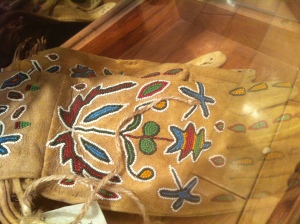Plains Indians Museum on Blackfoot Reservation
In the Blackfoot Indian Reservation town of Browning y0u can visit a museum specifically about the Indians of the Great Plains. Small, but well worth seeing.The exhibits show items organized by ‘transportation,’ ‘household,’ ornamentation men/women,’ ‘child raising/toys,’ and others. Special emphasis is on the trade bead making arts. The arts only began to flourish once the horse was introduced to the Plains Indians by the Spanish. The animals added enough efficiency to hunting and transportation that time was created for the arts.
Being a Blackfoot male during the 19th Century and before was a real bummer. As an adolescent you went out into the mountains, starved yourself, and hoped for a vision that would reveal a personal protector, like a coyote. After that your valuation by the tribe depended on crazy bravery deeds, like touching an armed enemy with your hand before killing him. I imagine that French-kissing a buffalo counted double. These things earned you feathers and respect. There was also mention of wisdom as a criterion, but it seems to me that the two measures are contradictory: you only get high scores in one: wisdom, or the French-kissing thing.
Particularly interesting was a section on just how the bead work is done. I learned some of what to look for. Too much, I think for everyone’s interest. Ask me if you care. Search keywords are ‘lazy stitch,’ and ‘overlay stitch.’
Unfortunately, all I can show you is the museum building. As you can see, it’s a fortress. Inside you find ‘No Photography’ signs everywhere. I interviewed a tribal member gift shop attendant, and he explained that people steal the designs, and then sell counterfeit products.
Here two examples from a Whitefish, MT store:

Geometric designs are typical, particularly for Western tribes, and the first half of the 19th century
Note that this first photo shows purely geometric designs, which were the staple of Western Plains Indian tribes. Then the Ojibwe tribes of the East exported curvilinear designs to their Western neighbors, opening many new capabilities, like these floral patterns.
Note also what has been ornamented: a gauntlet.
The tribes took the concept of gauntlet from the US military, and integrated them into their clothing.
These tiny beads are called trade beads, because they were imported from Europe (Venice and elsewhere). Indians traded them for furs.
Posted on July 6, 2011, in Uncategorized. Bookmark the permalink. Leave a comment.



Leave a comment
Comments 0